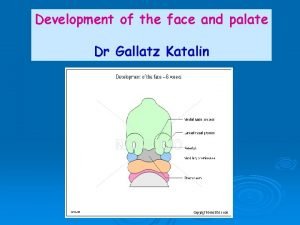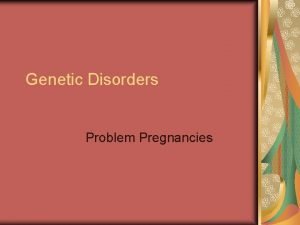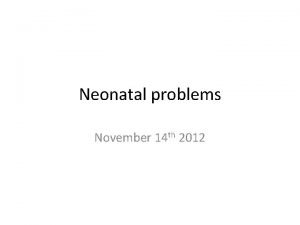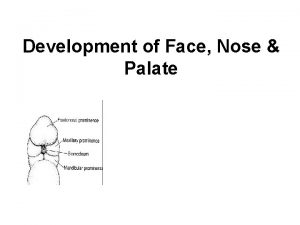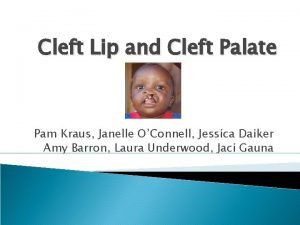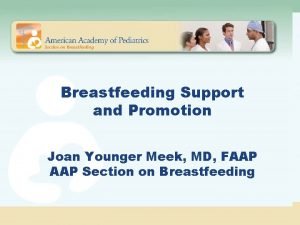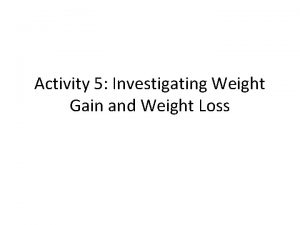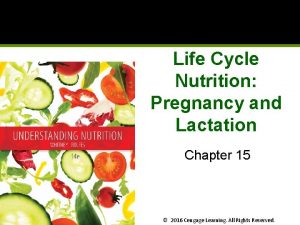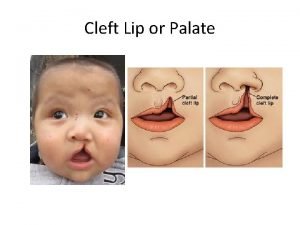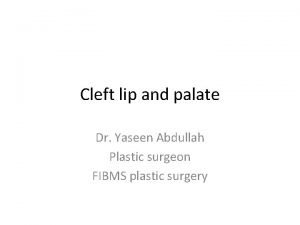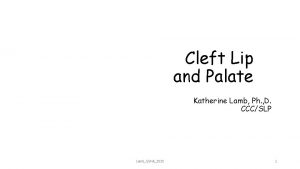Weight Gain in Children with Cleft Lip and



















- Slides: 19

Weight Gain in Children with Cleft Lip and Palate without Use of Palatal Plates Presented by Lisa Sharp-Gomez Research Article by Renato da Silva Freitas, Andrey Bernardo Lopes-Grego, Helena Luiza Douat Dietrich, Natacha Regina de Moraes Cerchiari, Tabatha Nakakogue, Rita Tonocchi, Juarez Gabardo, Eder David Borges da Silva and Antonio Jorge Forte 1 Center for Integral Assistance of Cleft Lip and Palate, Federal University of Parana , Cuitiba, PR, Brazil 2 School of Medicine, Yale University, New Haven, CT 06510, USA

What is a Cleft Lip? �Cleft Lip can be unilateral or bilateral

What is a Cleft Palate? �A Cleft Palate can involve hard palate, soft palate or both. It can occur with a cleft lip.

Clefting can result in: �Short, fast, uncoordinated or ineffective sucking. �Entrance of milk in the nasal cavity �This can cause sneezing and loss of formula �Excessive air ingestion �Lower weight gain �Shorter length (stature)

Study Background � This study was done in Brazil in 2012 at the Center for Integral Assistance of Cleft Lip and Palate with input from the Harvard School of Medicine � 112 patients ◦ 56 males ◦ 56 females � Followed � None from Birth to 1 year of the participants were fitted with a palatal plate or obturator.

What is a palatal plate A palatal plate (or obturator) is an individually fitted appliance inserted into the mouth to allow the infant to form a suction while feeding.

Is a Palatal plate necessary for good growth? �None of the children seen in the Center for Integral Assistance of Cleft Lip and Palate were fitted with a palatal plate �It was felt that education in proper feeding technique was adequate to insure appropriate nutrition and growth during the first year of life.

Methods: �Study ◦ ◦ participants classified by: Birth date Gender Cleft classification Type of milk consumed �Breast, formula or combination ◦ Length of exclusive breastfeeding ◦ Age of solid food consumption ◦ Monthly weight during the first year of life

Data Comparison: �Data gathered was compared to the data published by the World Health Organization with regards to average weight gain in children during their first year of life. �Data was gathered retrospectively from patients seen at the center from 2008 – 2009.

Results: �Formula was most commonly used – 36% of sample �Combination breast milk and formula used by 25% of sample �Exclusive breast milk was used by 8. 9% of the sample �It was felt by the researchers that there were parental difficulties collecting breast milk and that there was a lack of education available on breastfeeding a child with a cleft lip or palate. �Average for solid food introduction was 8 months

Results, cont: �Both boys and girls weight about 200 g less than average at birth �Boys weights lagged behind by almost 900 g at 3 months, but reached the WHO 50 th%ile by 10 months. �Girls weights lagged behind by 750 g at 3 months, but reached the WHO 50 th%ile by 9 months.

Weight comparison for boys

Weight comparison for girls

WHO comparison for girls

WHO comparison for boys

Discussion �Due to impaired sucking abilities, children with clefts have higher rates of malnutrition. �The majority children required ‘mechanical support’ to facilitate the flow of milk. �https: //www. youtube. com/watch? v=ER To. Vry 4 i. Zc

Discussion, cont. �The study found no statistical differences in the weights of children who used palatal plates and those who didn’t, so therefore did not recommend universal use of the plate. �The study supports corrective surgery between 9 -12 months.

Conclusion �It was determined that the type of cleft lip/palate and the type of milk consumed had no influence on weight gain or growth. �Factors which supported weight gain and growth were individually selected feeding methods, support, education, integrated multi professional care and regular follow ups.

Questions: �After listening to this research, what is your opinion about the use of palatal plates? �Do you feel that the weight gains at the clinic are adequate? �Comments? Questions?
 Cleft palate weight gain
Cleft palate weight gain Veau classification
Veau classification Classification cleft lip and palate
Classification cleft lip and palate Cleft lip and palate mcq
Cleft lip and palate mcq Palate
Palate Cleft lip and palate post operative care nursing diagnosis
Cleft lip and palate post operative care nursing diagnosis Labor day 2006
Labor day 2006 Cleft lip pallet
Cleft lip pallet Cleft lip
Cleft lip Oblique facial cleft
Oblique facial cleft Lip formation
Lip formation Cleft lip
Cleft lip Fluoxitine weight gain
Fluoxitine weight gain Weight gain in infant
Weight gain in infant Prite review
Prite review Ggg weight gain
Ggg weight gain Praiprism
Praiprism King lear context
King lear context Components of weight gain during pregnancy
Components of weight gain during pregnancy Justin moore weight gain
Justin moore weight gain




